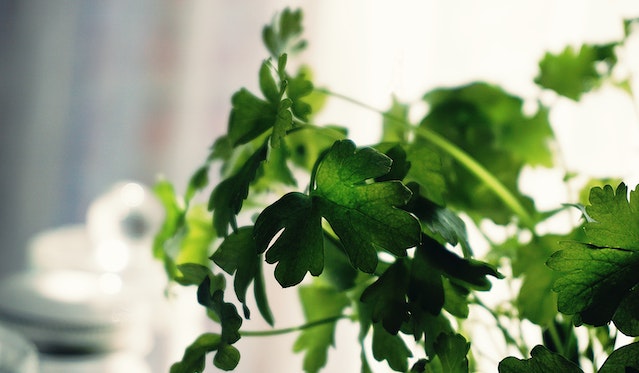Botanical Description:
Scientific Name: Coriandrum sativum
Family: Apiaceae (Carrot or Parsley Family)
Common Names: Cilantro, Coriander
Description: Cilantro, scientifically known as Coriandrum sativum, is an annual herb belonging to the Apiaceae family. It is native to regions spanning southern Europe, North Africa, and southwestern Asia. The plant has a slender, erect stem with finely divided, compound leaves. Cilantro produces small, white to pale pink flowers arranged in umbrella-like clusters. Both the leaves (cilantro) and the seeds (coriander) of the plant are utilized for culinary and medicinal purposes. Cilantro has a distinctive citrusy and slightly peppery aroma, contributing to its widespread use in various cuisines.
Disclaimer:
This Materia Medica is provided for informational purposes only and should not replace professional medical advice. Please consult with a qualified healthcare practitioner or herbalist before using any herbal remedies.
Therapeutic Actions:
- Digestive Aid: Cilantro is traditionally valued for its digestive properties, helping to alleviate indigestion and bloating.
- Anti-Inflammatory: Compounds in cilantro may possess anti-inflammatory properties, potentially beneficial for inflammatory conditions.
- Antioxidant Support: Cilantro contains antioxidants that may help neutralize free radicals in the body.
- Chelation of Heavy Metals: Some studies suggest that cilantro may aid in the chelation of heavy metals from the body.
- Antibacterial Properties: Cilantro exhibits antibacterial properties that may contribute to its use in supporting overall immune health.
Constituents:
- Essential Oils: Cilantro contains essential oils, including linalool and geranyl acetate, contributing to its aromatic and therapeutic qualities.
- Phenolic Compounds: Phenolic compounds, such as flavonoids and polyphenols, contribute to cilantro’s antioxidant and anti-inflammatory properties.
- Vitamins and Minerals: Cilantro is a source of vitamins A, C, and K, as well as minerals like potassium.
- Fatty Acids: Some fatty acids, such as petroselinic acid, are found in cilantro.
Traditional Uses:
- Digestive Health: Cilantro is employed traditionally to ease digestive discomfort, including indigestion and gas.
- Anti-Inflammatory Applications: The herb is used in traditional practices to address inflammatory conditions.
- Detoxification: Cilantro is believed to assist in the chelation of heavy metals from the body, supporting detoxification.
- Culinary Uses: Widely used in various cuisines, cilantro adds flavor and aroma to dishes, enhancing their nutritional profile.
- Antibacterial Support: Cilantro is valued for its potential antibacterial properties, contributing to overall immune support.
Dosage and Preparation:
- Fresh Cilantro: Incorporate fresh cilantro leaves into salads, soups, or dishes for culinary and potential medicinal benefits.
- Cilantro Tea: Prepare a tea by steeping fresh cilantro leaves in hot water for 5-10 minutes. Drink as needed.
- Cilantro Tincture: Tinctures may be available, and dosage should be in accordance with product recommendations.
Cautions and Considerations:
- Allergies: Individuals with known allergies to plants in the Apiaceae family (carrot, celery) should exercise caution.
- Pregnancy and Lactation: Pregnant or lactating individuals should consult with a healthcare provider before using cilantro in large amounts.
- Herb-Drug Interactions: Cilantro supplements or extracts may interact with certain medications. Consult with a healthcare professional if taking medications.
- Quality and Source: Ensure the cilantro used is fresh and from a reliable source to maximize its therapeutic potential.
Conclusion:
Cilantro, a versatile herb appreciated for its culinary and potential medicinal benefits, adds a distinctive flavor and aroma to dishes across cultures. Beyond its role in enhancing the sensory appeal of food, cilantro has a rich history in traditional medicine for its digestive, anti-inflammatory, and detoxification properties. Whether incorporated into daily meals or used as a tea, cilantro offers a blend of flavors and compounds that contribute to both the palate and well-being. As with any herb, it’s essential to consider individual sensitivities and consult with a qualified healthcare practitioner for personalized advice. Integrating cilantro into a balanced and varied diet can be a flavorful and healthful addition to a holistic approach to wellness.





